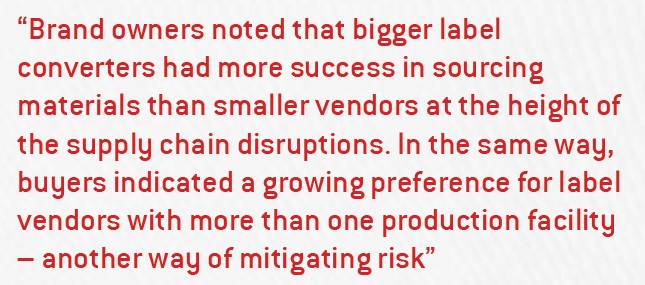Europe reels from multiple shocks
After successfully coming through the Covid pandemic, the European label industry has been hit by a series of shocks that are likely to have profound consequences through 2023

At the end of 2021 there was a great deal of optimism in the European label sector. The industry had grown by 7 percent, up from 4.5 percent in 2020. The worst impacts of the pandemic looked to be over, and any problems in the
supply chain were considered temporary as the labels industry underwent a rapid post-pandemic recovery. No inflationary pressures were on the horizon.
One year later and that situation has changed - and for the worse. Supply chain issues turned out to be structural,
a continued shortage of computer chips, and a months-long strike by UPM forestry workers. Then on 24th February
Russia invaded Ukraine. Alongside the humanitarian catastrophe, Europe experienced surging inflation in energy and raw materials costs and further blockages in the supply of raw materials critical to the manufacture of label machines, materials and consumables.
Labelstock consumption down
A Finat survey in the middle of last year found that 60 percent of converters had suffered financial losses of up to 6.6 percent as a direct result of label industry supply
chain issues. Losses of over 4 percent were caused by problems in the wider packaging supply chain.
At the same time, rapidly increasing inflation reduced European consumers’ disposable incomes, impacting what they have available to spend on packaged goods of all kinds.
These multiple crises and uncertainties heavily impacted the last quarter of 2022. Compared to the fourth quarter in 2021, European consumption of paper and filmic roll labelstocks decreased by no less than 24 percent, the sharpest year-on-year decline in a single quarter recorded since Finat commissioned the collection of quarterly statistics in 2003.
Finat managing director Jules Lejeune explains: ‘the contraction in demand is a correction of the erratic market behavior in the previous three quarters that started with the long-lasting paper strike in Finland, the resulting paper shortages and increasing lead times, the refilling of label converter warehouses in the third quarter and the mounting general economic uncertainty in the intermediate period caused by the Russian invasion of Ukraine, rising energy and raw materials costs, rising interest rates and a looming
recession due to losses in disposable incomes of European consumers.’

As a consequence, label converters made the decision to wind down inventories toward the end of the year and postponed the procurement of new label stock.
Label buyers remain positive
Despite this downturn, label buyers remained positive about the industry’s prospects moving into 2023.
In the latest Finat Radar report, released in December, 85 percent of the 60 brand owners interviewed expected their label procurement to increase or at least remain stable in 2023.
Of course, we will need to see if these intentions hold up given the recent economic forecasts for European growth,
but it is an encouraging sign.
Over half the brand owners interviewed indicated that their companies had experienced ‘significant’ label supply chain
issues in 2022, and this has impacted their buying behavior. For example, brand owners noted that bigger label converters had more success in sourcing materials than
smaller vendors at the height of the supply chain disruptions. In the same way, buyers indicated a growing preference for label vendors with more than one production
facility – another way of mitigating the risk from shortages and other disruptions in order fulfillment.
The 2022 Radar report also looked at the impact of the post-Covid landscape on end-use label sectors.
Not surprisingly, the report showed food and beverage sectors growing the fastest at more than 8 percent, followed by retail at 7.5 percent, transport and logistics at 6.5 percent, personal care at 5.9 percent, with pharma and household chemicals at just over 4 percent. Industrial chemicals and consumer durables posted respectable
growth rates of 3.1 percent and 2.8 percent. The only sector to decline growth was automotive, which shrank by 1.4 percent.
A survey of capital equipment buying intentions showed that 29 percent of converters said they planned to invest in conventional presses in 2022, almost certainly a result of the higher order volumes placed during the pandemic.
For 2023 that figure was down to 14 percent, with 33 percent planning to invest in digital – better suited perhaps
to the need to remain agile in a period of continued uncertainty.
Stay up to date
Subscribe to the free Label News newsletter and receive the latest content every week. We'll never share your email address.


